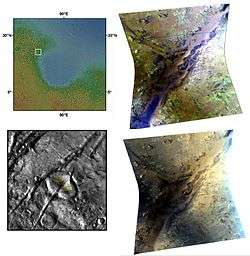Nili Fossae
|
Nili Fossae as seen by CRISM. Top left: location of observation. Bottom left: context of observation. Top right: yellow-brown areas denote olivine, bright green areas denote phyllosilicates and purple areas pyroxene. Bottom right: approximate true-color view of the target area. | |
| Coordinates | 22°34′N 76°48′E / 22.57°N 76.8°ECoordinates: 22°34′N 76°48′E / 22.57°N 76.8°E |
|---|---|
| Length | 667.0 |
Nili Fossae is a group of large, concentric grabens on Mars, located in the Syrtis Major quadrangle. They have been eroded and partly filled in by sediments and clay-rich ejecta from a nearby giant impact crater, the Isidis basin.[1] It is located at approximately 22°N, 75°E, and has an elevation of −0.6 km (−0.37 mi). Nili Fossae was on the list of potential landing sites of the Mars Science Laboratory, arriving in 2012, but was dropped before the final four sites were determined. In September 2015, it was selected as a potential landing site for the Mars 2020 rover, which will use the same design as Curiosity, but with a different payload focused on astrobiology.
A large exposure of olivine is located in Nili Fossae.[2] In December 2008, NASA's Mars Reconnaissance Orbiter found that rocks at Nili Fossae contain carbonate minerals, a geologically significant discovery.[3][4][5] Other minerals found by MRO are aluminum smectite, iron/magnesium smecite, hydrated silica, kaolinite group minerals, and iron oxides.[6] NASA scientists discovered that Nili Fossae is the source of plumes of methane, raising the question of whether this source originates from biological sources.[7][8]
Researchers in July 2010 suggested that carbonate bearing rocks found in the Nili Fossae region of Mars are made up of hydrothermally altered ultramafic rocks. Consequently, hydrothermal activity would have provided sufficient energy for biological activity. Evidence of living organisms could have been preserved.[9]
Nili Fossae trough is thought to have resulted from the impact that formed the nearby Isidis basin.[10][11]
| Wikimedia Commons has media related to Nili Fossae. |
Nili Fossae Trough was one of seven finalists for the MSL landing site:[12]
- Eberswalde Crater
- Gale Crater
- Holden Crater
- Mawrth Vallis
- Miyamoto Crater
- Nili Fossae Trough
- Southern Meridiani
References
- ↑ Grotzinger, J. and R. Milliken. 2012. Sedimentary Geology of Mars. SEPM.
- ↑ Hoefen, T.M., et al. 2003. Discovery of Olivine in the Nili Fossae Region of Mars. Science 302, 627-630. "http://www.sciencemag.org/content/302/5645/627"
- ↑ Nasa finds 'missing' Mars mineral
- ↑ http://www.space.com/30746-mars-missing-atmosphere-lost-in-space.html?cmpid=NL_SP_weekly_2015-10-06
- ↑ Edwards, C., B. Ehlmann. 2015. Carbon sequestration on Mars. Geology: doi: 10.1130/G36983.1.
- ↑ Murchie, S. et al. 2009. A synthesis of Martian aqueous mineralogy after 1 Mars year of observations from the Mars Reconnaissance Orbiter. Journal of Geophysical Research: 114. E00D06.
- ↑ Mars Methane Found, Raising Possibility of Life
- ↑ New light on Mars methane mystery
- ↑ Adrian J. Brown, Simon J. Hook, Alice M. Baldridge, James K. Crowley, Nathan T. Bridges, Bradley J. Thomson, Giles M. Marion, Carlos R. de Souza Filho, Janice L. Bishop. 2010. Hydrothermal formation of Clay-Carbonate alteration assemblages in the Nili Fossae region of Mars. Earth and Planetary Science Letters, 2010; doi:10.1016/j.epsl.2010.06.018
- ↑ Potential Mars Science Laboratory Landing Site: Nili Fossae Trough
- ↑ Craddock, R. 1994. Geological history of Isidis Planitia and Syrtis Major Planum, Mars. Houston, Texas, LPS XXV. 291-292
- ↑


